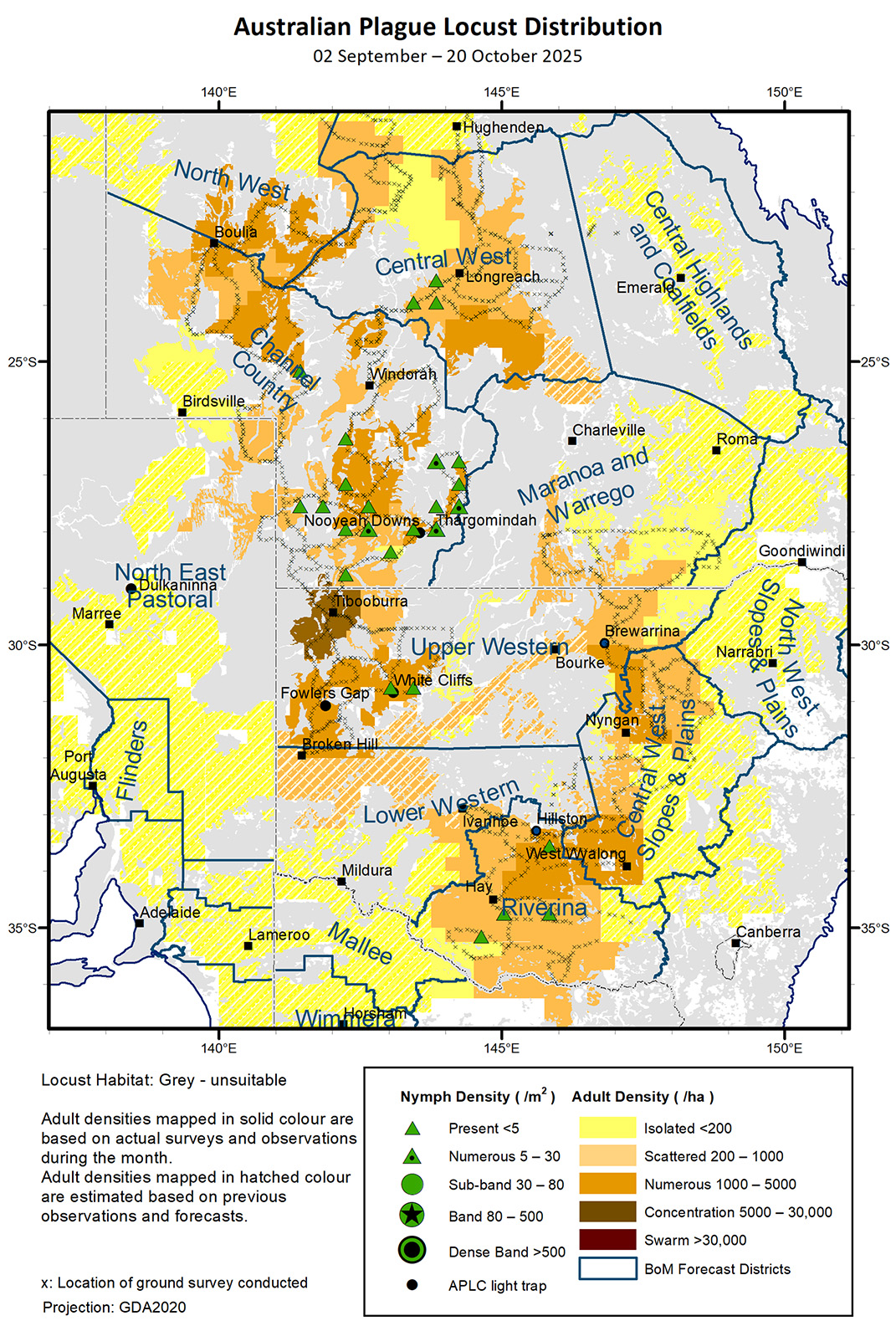Locust situation November 2025
This page summarises the known distribution of locusts during early spring 2025 and provides a brief outlook to Janurary 2026. Regional information and forecasts are given in the latest Locust Bulletin.
The overall locust population was at low-medium levels across inland eastern Australia. Surveys identified frequent low-density and some medium-density adults in Queensland and New South Wales with occasional low-density nymphs detected except for the Channel Country where frequent low-density and some medium-density nymphs were observed. These late-instar nymphs detected in the Channel Country in mid-October likely hatched after mid-September rains from quiescent overwintering eggs laid in last Autumn. No locust captures were recorded by any light traps in Dulkaninna of South Australia, Fowlers Gap and White Cliffs of NSW. The light trap in Thargomindah of Queensland has not been in operation since August due to lack of operator. The UNSW insect monitoring radar in Hay was back in operation since mid-October but did not detect any significant migration of locust. No surveys were conducted in Victoria and much of South Australia except for its northeast corner. Several reports of high-density grasshoppers were received from the Flinders district of SA in late October. Investigation confirmed these appeared to be mostly Small Plague Grasshopper Austroicetes cruciata.
Apart from the significant rainfall (200 – 600 mm) received by inland Queensland during late March and early April, much of inland eastern Australia experienced a dry autumn and winter with less than 25 mm of monthly totals. Despite much of inland NSW and parts of the adjacent Channel Country where 25 – 60 mm of rainfall (above average to very much above average levels) was received for September, inland eastern Australia continued in dry conditions with monthly rainfall totals of less than 25 mm for September and October, ranging from average to very much below average levels historically. After the warmer autumn and cooler winter (largely attributed to lower overnight temperatures), the spring had been warmer with both higher daytime and overnight temperatures. With the forecast for above average rainfall and warmer temperatures for the rest of spring and early summer, some habitats may become favourable for locust breeding. Although El Niño–Southern Oscillation remains neutral there are signs towards La Niña for the coming summer.
The overall outlook is for low-medium density populations across inland eastern Australia, with possible localised higher densities developing in inland Queensland and parts of NSW if sufficient rainfall is received.
There is a low likelihood of widespread infestations developing in late spring and early summer.
The overall population was at low-medium levels across inland eastern Australia with consistent medium-density adults detected in Central West of Queensland and adjacent districts. Low-density adults were occasionally identified in surveyed areas of NSW. No capture was recorded by any light traps in White Cliffs and Fowlers Gap of NSW, and Dulkaninna of South Australia. With the forecast of above average rainfall, some habitats should remain favourable for locust survival and breeding.
There is a low-moderate risk of a regional infestation in Central West Queensland. However, a widespread infestation is less likely to occur in late spring and early summer.
The population decreased markedly in Central West and North West districts of Queensland after continuous northwest-wards movements of adult populations during winter and early spring and deteriorating habitat conditions. However, some localised high-density nymphs and fledglings were still identified in the Clermont area where the Queensland Department of Primary Industry (QDPI) conducted some aerial control in early October. QDPI had assessed two-dozen reports from the Central Highlands and Central West districts during September and October. Several late reports were received from sugar cane growers in the coast region. With the good background population, sufficient rainfall will encourage locust breeding and produce some localised high-density populations.
There is a moderate risk of a regional infestation developing in the Central Highlands and a low-moderate risk in the Central West and Darling Downs during late spring and early summer.
The population decreased markedly in Central West and North West districts of Queensland after continuous northwest-wards movements of adult populations during winter and early spring and deteriorating habitat conditions. However, some localised high-density nymphs and fledglings were still identified in the Clermont area where the Queensland Department of Primary Industry (QDPI) conducted some aerial control in early October. QDPI had assessed two-dozen reports from the Central Highlands and Central West districts during September and October. Several late reports were received from sugar cane growers in the coast region. With the good background population, sufficient rainfall will encourage locust breeding and produce some localised high-density populations.
There is a moderate risk of a regional infestation developing in the Central Highlands and a low-moderate risk in the Central West and Darling Downs during late spring and early summer.

